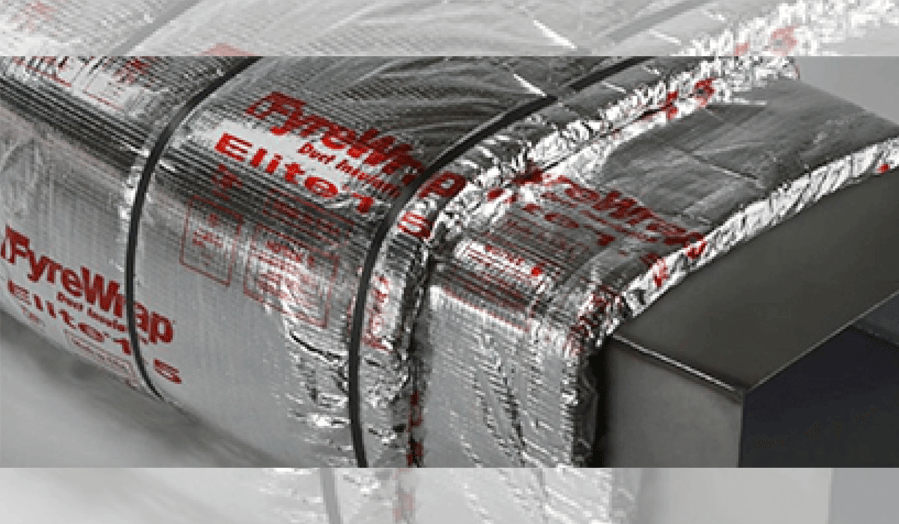
Countless things keep your building safe and functioning properly, from the bricks in the foundation all the way to plumbing and electrical components. However, to stay protected day in and day out and to avoid emergencies, building systems need help, too. This help comes from fire wraps — or fire blanket insulation — which protect against fire damage.
Using fire wraps throughout your building is not rocket science, but you do need to understand their value and use them the right way. Below, we highlight common fire wrap mistakes and provide guidance on how to avoid them.
What Is Fire Wrap?
Fire wrap is high-temperature passive fire protection that protects buildings and components from fire and toxic smoke. It is designed to provide fire protection for a wide range of systems, such as:
- Air ventilation ducts
- Hazardous chemical exhausts
- Dryer vents
- Water heaters
- Commercial kitchen grease ducts
- Plastic pipe and cable
These products work to reduce heat transfer to prevent ignition. Fire wrap is traditionally 1/2” or 1-1/2” thick and can be fully encapsulated in foil, increasing its fire rating. Fire wrap is effective when installed correctly and has the potential to save lives and prevent damage. With that in mind, it helps to be aware of common missteps so you can avoid them.
3 Common Fire Wrap Mistakes
As insulation experts, we help businesses out of sticky situations regularly, righting the ship so they can operate more safely. Because of this, we have pinpointed a small selection of the most common mistakes specific to fire wrap products and installation.
1. Using the Wrong Product for Your Application
The fire wrap you need in one situation will not necessarily meet all of your needs. Fire wraps have different applications, and you need the right product in each circumstance.
Example: The products you may need for a chemical manufacturing facility may be completely different from what is required in a commercial office building.
Fire wraps are designed and rated with specific use cases in mind, capable of withstanding certain temperature thresholds for a set number of hours. If you fail to use the correct product, the fire wrap won’t provide the intended degree of protection.
2. Leaving Incorrect Annular Spaces
Annular space is the space, or gap, between a firestop and the opening of installation. Your contractor needs to know how much space to leave so your fire wrap can perform adequately. If you leave too little or too much annular space, the results can be deadly. Smoke or fire can leak through a gap in the wall and spread quickly, threatening people and structures. One way to mitigate this risk is to use a fire wrap made from a malleable material that can easily expand and contract.
3. Assuming All Products Are Installed the Same Way
Think about your car’s windshield wipers. One is probably a different size and shape than the other, and each has to be installed in a particular way so they can work together to wick away rain adequately.
The same is true when you install fire wrap: Each situation calls for a specific way to install fire wrap products, because different products have unique needs. This goes all the way to the manufacturer level because each manufacturer has their own installation process. Some require you to butt up edges together, whereas others say to overlap the wrap. Always follow installation guidelines for your product. Your product may not completely fail if it is installed based on another manufacturer’s instructions, but it will not provide the full protection it was designed for, either!
The Importance of Fire Protection in Construction
You need to think about fire protection from the moment you break ground on (or receive your Certificate of Occupancy to move into) your building. Your preparation early on ensures comprehensive building safety and accounts for what your contractors may overlook.
Fire Protection Protects the Whole Building
Accidents happen, and fire protection — including fire wraps — protects everything, from electrical wiring to plumbing pipes to mechanical systems. Of course, it isn’t just components or rooms at risk. People across the world have been killed in fires when they were not in the room of the fire’s origin, so fire protection is also essential to the health and safety of commercial and industrial workers.
Contractors Are Not Firestop Experts
Contractors may be experts in their fields, but that doesn’t make them experts in fire safety. If they are not familiar with firestop installation, your contractor may use materials that are not tested or approved — or just assume that a particular building product already has a firestop function.
Example: Building materials used to seal joints — like drywall — do not necessarily provide fire protection.
If your contractor does not use the right materials, your building will fall short of U.S. model building codes. You need to ensure the use of approved fire protection materials so you will not fail inspections and put workers at risk. Start by educating contractors and workers to properly identify materials with firestopping capability. Training should cover:
If you need a starting point, take a peek at Distribution International’s DI 101 Webinar Series. The series offers in-depth education on all modes of installation, led by industry experts. Simply share the insights with your contractors!
Get the Right Fire Wrap From Distribution International
It is easy to get overwhelmed when you need to install fire wrap throughout your building. However, it is imperative to avoid mistakes such as improper installation or using the wrong product. Distribution International can get you on the right course. We offer a wide variety of fire wrap products to suit your building’s needs. Explore our fire wrap selection online, and get in touch with an expert to order the right products for your application!